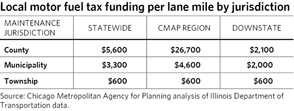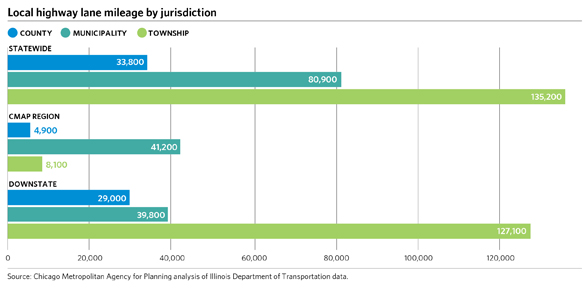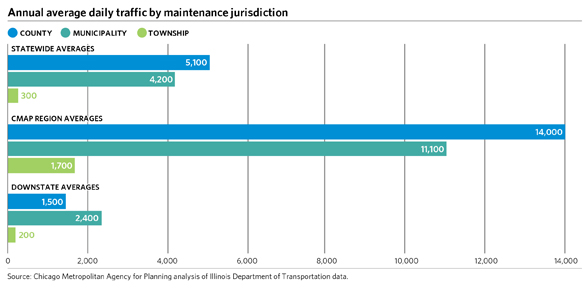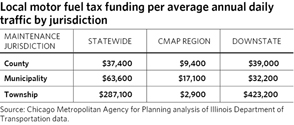This is the second in a series of three Policy Updates on the structure of transportation funding programs in Illinois, as well as the governance of the state and local highway system. The first post provided background information on the local motor fuel tax (MFT) allotments shared by the state with counties, municipalities, and townships, in addition to other transportation revenue-sharing programs. This post evaluates the effectiveness of the Illinois local MFT sharing program. The final post explores the relationship between municipalities and townships in the local highway system and its funding.
Illinois law is very specific regarding the funding percentages and distribution of local MFT allotments to counties, municipalities, and townships or road districts, though the resulting dollar amounts are not necessarily tied to service needs. Furthermore, as set percentages, the method of apportioning funds cannot respond to changing needs over time. Funding "needs" have multiple dimensions and can be difficult to define and measure. This Policy Update evaluates the Illinois method of sharing MFT revenues with local governments. The analysis focuses on two high-level metrics: total system mileage (as measured by lane miles) and total traffic on the highway system (as measured by average annual daily traffic, or AADT). Total mileage reflects the overall extent of the highway system and acts as a rough proxy for maintenance needs; AADT reflects the overall use of the highway system.
The Illinois Department of Transportation (IDOT) distributed $553 million and $545 million in MFT revenues in 2012 and 2013, respectively, to 2,857 units of local government. In both years, jurisdictions in the seven-county CMAP region received about 60 percent of these local MFT allotments. While the CMAP region receives relatively large allotments of local MFT funding per lane mile, its allotments are relatively small when considering traffic volumes.
The following CMAP staff analysis is based on data from the 2012 edition of the Illinois Roadway Information System (IRIS). The IRIS is available for download from the IDOT website, as is a user's manual.
Lane miles
There are some 249,942 lane miles of highways in Illinois maintained by local jurisdictions, including counties, municipalities, and townships, according to the IRIS. A "lane mile" refers to the length of the roadway multiplied by the number of lanes. In other words, a two-lane road that is five miles long contains ten lane miles, and an eight-lane road that is also five miles long contains 40 lane miles. This definition contrasts with "centerline miles," which refers to the length of the roadway but does not include its number of lanes (both of the examples referenced would have five centerline miles, despite quite different lane-mileage). Lane miles are a better representation of the size of a facility and the extent of a jurisdiction's highway system.
For the most part, jurisdictions own and maintain their roads, but there are a small number of cases in which a portion of one jurisdiction's roadway is maintained by another jurisdiction. Because data are not readily available to document each maintenance agreement across jurisdictions, these miles are excluded from the analysis. These lane-miles represent very small shares of total mileages statewide, and excluding them is not expected to change the overall conclusions of the analysis.
As the following figure demonstrates, the majority of the local highway system in Illinois is maintained by townships, whereas the majority in the CMAP region is maintained by municipalities. While the CMAP region contains only 6 percent of all township lane miles and 14 percent of all county lane miles in the state, it is home to 51 percent of municipal lane miles.
In 2013, counties in Illinois received $191 million in local MFT allotments, municipalities received $267 million, and townships received $87 million. The distribution of funds per lane mile tells a slightly different story. Counties received the most funding per lane mile across the state. This pattern holds both within the CMAP region and downstate, but the county funding is especially pronounced in the CMAP region. This reflects the special role of Cook County, which, as the only county in Illinois with over 1 million residents, receives a separate allotment of 16.74 percent.

Click for larger image.
According to its Department of Highways and Transportation, Cook County maintains 1,474 lane miles of highway. In 2013, Cook County received over $91 million in local MFT allotments, which corresponds to $61,900 per lane mile. The remaining six counties in the CMAP region receive an average of $11,500 per lane mile, over three times the rate for county highways statewide.
Municipalities in the CMAP region received more than twice the local MFT funding per lane mile than their downstate counterparts. Because municipalities receive their MFT allotment based on population, the higher per-mile funding in the CMAP region suggests relatively fewer road miles per person (i.e., denser development) in northeastern Illinois. In contrast to counties and municipalities, the township MFT allocation was about the same per lane mile in the CMAP region as downstate. This is unsurprising as MFT funds are distributed to townships based on lane miles.
Average annual daily traffic
AADT reflects the use of the roadway and is assigned to a segment of roadway, rather than the system as a whole. Therefore, the analysis in this section relies on the average AADT of roadway links in each jurisdiction. It is important to note that the IRIS file does not contain AADT data for all roadways in the state, and so the averages reported here only reflect the roadway links for which data is available. About 99.7 percent of all county highway links, 34.4 percent of all municipal highway links, and 71.3 percent of all township highway links in IRIS contained AADT data.
The preceding chart demonstrates that the average AADT for roadways in the CMAP region is substantially higher than that for the state as a whole. In the CMAP region, the AADT for county highways is 2.7 times higher than that of county highways in the state as a whole, and municipal highways have an AADT that is 2.6 times higher. Township roads in the CMAP region also experience more traffic, with AADT counts 8.7 times greater than the statewide average.
Jurisdictions in the CMAP region receive less funding per traffic level than their downstate counterparts. Northeastern Illinois municipal and county highways have relatively high traffic volumes compared to those in the rest of the state, resulting in lower local MFT funding per AADT. While some townships in northeastern Illinois are ineligible to receive local MFT allotments, those that do qualify have relatively high traffic volumes compared to townships in the rest of the state. As such, the local MFT funding per AADT in the CMAP region is much lower than the state as a whole.
Specifically, counties in the CMAP region receive roughly one-quarter of the local MFT allotment per AADT compared to the statewide county average. This difference is even more pronounced for Cook County, which receives about $6,100 per AADT, or only about one-sixth of the statewide county average. Municipalities in the CMAP region receive about 27 percent of the local MFT funding per AADT compared to the statewide average, and townships in the CMAP region receive less than 1 percent.
Conclusion
In focusing on two broad measures, this analysis does not capture all dimensions of transportation funding needs. For example, it does not include measures of infrastructure condition, such as pavement or bridge condition ratings. While the IRIS does provide data on the Condition Rating Survey (CRS), a measure of pavement quality, very few highway links contain this data. In fact, only 4.8 percent of county highways, 2.0 percent of municipal highways, and 0.1 percent of township highways report CRS data within IRIS.
Nevertheless, this analysis does help illustrate the effectiveness of the local MFT sharing program. While the first table shows the CMAP region receiving relatively large allotments of local MFT funding per lane mile, the following table demonstrates that northeastern Illinois receives relatively small allotments per AADT. As an example, municipalities in the CMAP region account for 71 percent of all local MFT allotments to municipalities in Illinois, which compares to their 51 percent share of lane miles. But the average traffic volume for a municipal highway in the CMAP region is 264 percent that of a municipal highway in the state as a whole. In other words, the CMAP region has relatively few lane miles of highway compared to the state as a whole, but these highways are heavily trafficked.
Determining a jurisdiction's "need" and related funding requirements is complex, and different measures of need suggest different funding outcomes. The final post in this series will explore the relationship between municipalities and townships in the local highway system and its funding.


